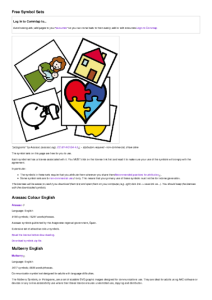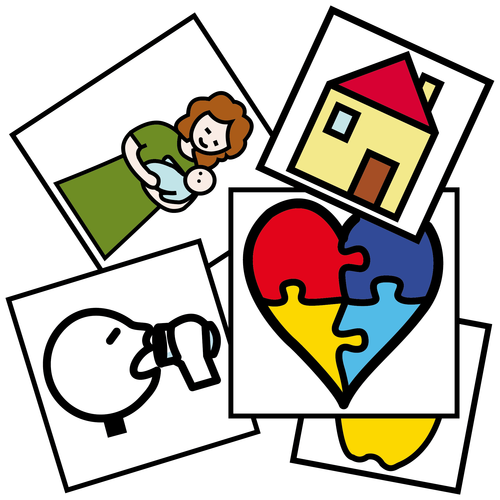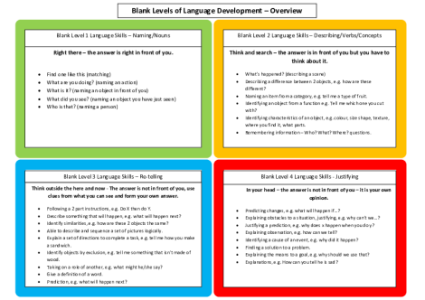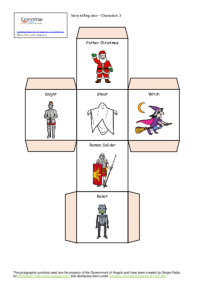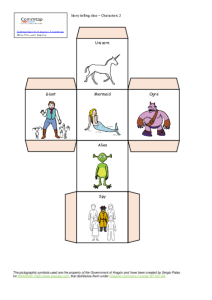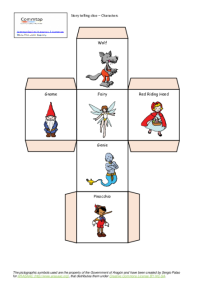Search
User login
Topic “Narrative/story-telling”
think and talk about events in the past and future
| Activity/strategy name and materials required | How to do the activity | Key principles for doing the activity and comments |
|---|---|---|
| Which day? Sheet of paper with 3 boxes drawn on them for yesterday, today and tomorrow. A counter. Optional: sets of symbol cards or pictures showing a variety of activities - including activities the student may have done. You can create symbols cards using the Commtap Symboliser for PowerPoint. | 1. Talk about each day, one at a time. Get the student to draw or write things they have done or will do in each box. Use the picture symbols if the student is having difficulty coming up with things. 2. When you have finished, explain that there is going to be a quiz. Describe an activity and the student must say if they did it yesterday, did it today or will do it tomorrow. 3. Have them step the counter over onto the right day. | This works best when there are key things which are different about each day! |
| The Story of Fred Set of three pictures - one showing a picture of a child, one showing a picture (preferably of the same person!) at a similar age to the student and one a picture of an older person. These could be photographs or drawings. Choose three ages which are appropriate/relevant for the student.
Large 'thought clouds ' on A3 or A4 paper: Sticky tape Pens Picture symbol prompts if required. You can create symbol prompts using the Commtap Symboliser for PowerPoint. | ||
| Calendar Calendar Pens | This is an ongoing activity. You could take photos of the key events, and put them on the calendar. | |
| Daily Schedule/Picture Schedule Any activity or set of activities where the student might use a schedule or have a visual timetable. You can create a visual timetable/schedule using the Commtap Symboliser for PowerPoint. |
Sequence three pictures related to hygiene
| Activity/strategy name and materials required | How to do the activity | Key principles for doing the activity and comments |
|---|---|---|
| Self Care Activities Camera to make the picture sequences (or alternatively you can draw them or use a commercial resource). Resources as appropriate to carry out a simple sequence Examples of sequences: Clean teeth: get toothpaste, open lid, get brush, squeeze toothpaste onto brush, put lid back onto toothpaste, brush teeth, spit out, put brush under water, repeat, clean brush, put brush away. Wash hands: turn on tap, rinse hands, put soap on hands, scrub hands, rinse under water, turn tap off, dry with towel. Brush hair: get brush, brush hair, put brush away. Deodorant: get deodorant, take off lid, spray at appropriate area, put lid back on, put away. | 1. Carry out the sequence without the pictures; 2. Do it again, showing the relevant picture for each part of the activity as you do it; 3. Get the student to do the sequence, showing them a picture for each part of the sequence as they do it; 4. Get them to show you what to do by giving you a picture for each part of the sequence. Try to do exactly as the picture you are given indicates, for example if they give you a picture of scrubbing your hands before the tap is turned on/before you have the soap, try to do this - but appear confused when this doesn't work. | At this level students may often be able to learn particular sequences of pictures without understanding that they relate to a sequence of actions, these activities are designed to address this issue. Seeing how the sequence goes wrong if the wrong picture is chosen (in step 4) will encourage the student to work out which should have been the right picture without you needing to give any further feedback. |
Talk about things in the recent past
| Activity/strategy name and materials required | How to do the activity | Key principles for doing the activity and comments |
|---|---|---|
| What have you done today? Optional - way of recording students responses - e.g. paper/pen, whiteboard/marker |
| Variations
|
| What have you done today - with a ball Optional - way of recording students responses - e.g. paper/pen, whiteboard/marker Soft ball or beanbag |
think and talk about events in the past and future
| Activity/strategy name and materials required | How to do the activity | Key principles for doing the activity and comments |
|---|---|---|
| Which day? Card with 3 boxes, for yesterday, today and tomorrow A jumping frog (or any other toy animal that jumps!) | 1. Talk about each day, one at a time. Have the child draw or write key things they have done or that they will do in each box. 2. When you have finished, explain that there is going to be a quiz. Describe an activity and the child must say if they did it yesterday, today or if they will do it tomorrow. 3. Have them jump the frog onto the right day. | This works best when there are key things which are different about each day! |
| Walter the Worm Set of three toy animals - a small one, a medium sized one, and a large one - all the same colour - for example three plastic worms
Large 'thought clouds ' on A3 or A4 paper: Sticky tape Pens | * It is better to do this over at least two sessions. If the child is finding it easy to think about this, you could repeat the activity but have the child think about when he was a baby, and then about when he is grown up. | |
| Calendar Calendar Pens | This is an ongoing activity You could take photos of the key events, and put them on the calendar | |
| Visual Timetable Any activity where you use a visual timetable This activity is also suitable for working with children at lower levels: for example to develop communication about past present and future experiences (English Speaking P7), and sequence pictures of daily events (Maths Shape Space and Measures P8). You can make a visual timetable with symbols using the Commtap Symboliser for PowerPoint.
|
Does actions in familiar number rhymes
| Activity/strategy name and materials required | How to do the activity | Key principles for doing the activity and comments |
|---|---|---|
| Number action rhymes | Follow the instructions on the number action rhymes sheet. |
Sequence pictures, symbols, words
| Activity/strategy name and materials required | How to do the activity | Key principles for doing the activity and comments |
|---|---|---|
| Writes about simple pictures e.g. of a dog/cat etc Letter tiles or letter cards, clear simple pictures | 1. Stick the chosen picture into a book. 2. Draw short lines under the picture to stand for the letters of the picture. 3. Help the child select letter tiles or alphabet cards to put on the lines. Can you do some of the letters and the child finishes off the last letter? 4. Can the child copy the letter tiles to write about the picture? 5. As the child becomes familiar with the activity make 2 word descriptions of pictures etc | Choose motivating pictures for the child to write about. Give lots of help with writing and lots of rewards for attempts. Make sure words to be written are familiar and short |
| Writes 3 words to describe a photo Photos of child engaged in clear actions e.g. going into dinner, playing outside, reading a book | 1. Look at a photo with the child and encourage the child to talk about it. Write down 3 or 4 words about the photo using words the child is very familiar with. 2. Print out child's descriptive words in large type on computer. 3. Cut the printed words up. Can the child sequence the words to match the photo and stick the words under the photo. 4. Encourage the child to draw a picture of the photo and to copy the matching descriptive print. 5. Select a photo and encourage the child to talk about it. You start the writing to describe the photo e.g the first word. Can the child finish off the writing? It may help to draw dots for the child to write over to begin with. | |
| Describes a picture from a favourite book Photo copies of some favourite pictures Photo copies of the pictures' matching print | ||
| Colours and then describes a picture A black and white picture to colour. Colouring pens | ||
| Describes own drawing Letter tiles and alphabet cards | ||
| Uses the computer to write about a picture |
Sequence pictures of familiar routines or a story
| Activity/strategy name and materials required | How to do the activity | Key principles for doing the activity and comments |
|---|---|---|
| Stories using miniatures Play people, bricks, etc. as required Can be done 1:1 or in a small group Suggestions for stories: 1. dad, mum, baby, bike, bricks: dad: bye bye baby, bye, bye mum, etc., gets on bike, drives into bricks, falls off; 2. helicopter rescue: helicopter comes and rescues those on an island; 3. dog eats picnic when others aren't looking; 4. fire!: children spot a fire in a building - make a story about what they do next; 5. swim across crocodile infested river. | 1. Show the child a story with the miniatures; 2. Get child to redo the story using the miniatures; 3. With the child make simple drawings for each key part of the story (the drawings do not need to be works of art); 4. Cut the pictures up and get the child to put them back in the right order; 5. Check if the story still works if you follow the sequence of pictures. The stories can also be physically acted out. | Children can get automatic feedback from this - if the pictures are in the wrong order the stories won't usually work - for example the brick tower can't be knocked down if the picture for it being built hasn't yet been used. Look puzzled when you can't do this bit of the story giving the child the opportunity to try and rectify the problem by re-ordering the pictures. |
| Any activity sequence in the classroom For example: 1. getting materials required for an activity; 2. lining up; 3. making a drawing; 4. a simple game you play; 5. going to assembly; 6. turning on and listening to a tape recorder/CD/MP3 player; 7. Switching on a computer and doing something on it; 8. opening a pot of bubbles and blowing them; 9. making a sandwich; 10. (a little more complex): playground games such as 'had', 'hide and seek', 'football' Materials as required. | 1. Do the activity; 2. With the child make simple drawings for each key part of the activity (the drawings do not need to be works of art); 3. Cut the pictures up and get the child to put them back in the right order; 4. Try to follow the sequence of pictures to see if it works. | Children can get automatic feedback from this - if the pictures are in the wrong order the sequence won't usually work. Look puzzled when a bit of the activity can't be done giving the child the opportunity to try and rectify the problem by re-ordering the pictures. |
| Books Familiar book Photocopied pictures | As a reward you could allow the child to colour or stick, or to make a book out of pictures to take home. | |
| Picture sequencing Published sequencing cards (e.g. LDA cards) Or worksheets with 3-4 picture sequences (Black Sheep have some ready made ones) | If the child is finding it difficult, remind the child of what is happening in each picture. If the child puts the pictures in the wrong order, tell the story as it is (e.g. The boy gave the flowers to his mum, then he saw the flowers in shop, then he bought the flowers.) Ask the child if the story makes sense. If the child is still finding it hard, tell them what the first picture is. You could ask the child to think about what might happen next in the story. | |
| Photocopied pictures from a familiar story | As above | |
| Photo shoot! Photos of the child doing an everyday activity (i.e. a sequence of them) |
Sequences three pictures showing a practical activity
| Activity/strategy name and materials required | How to do the activity | Key principles for doing the activity and comments |
|---|---|---|
| Practical sequences Camera to make the picture sequences (or alternatively you can draw them or use a commercial resource). Resources as appropriate to carry out a simple sequence Examples of sequences (with suggested steps to make pictures for): Putting on a jumper (get jumper, put head through, put arms through); Drinking a drink (jug and cup, pour water into the cup, drink it) Peeling and eating a piece of fruit (fruit, peel fruit, eat it) Going to the door and lining up Sitting down and eating dinner Drawing a picture (pencil and paper, child drawing, finished picture) Bubbles (unscrew lid, remove wand, blow bubbles) Looking at a book (get it, open it, look at it) | 1. Carry out the activity without the pictures; 2. Do it again, showing the relevant picture for each part of the activity as you do it; 3. Get the child to do the sequence, tell them what to do by showing them a picture for each part of the sequence; 4. Get them to show you what to do by giving you a picture for each part of the sequence. Try to do exactly as the picture you are given indicates, for example if they give you a picture of someone blowing bubbles without having given you the step for opening the bubbles container, try to blow the bubbles anyway (and act being disappointed when you don't get any bubbles). | At this level children may often be able to learn particular sequences of pictures without understanding that they relate to a sequence of actions, these activities are designed to address this issue. Seeing how the sequence goes wrong if the wrong picture is chosen (in step 4) will encourage the child to work out which should have been the right picture without you needing to give any further feedback. |
Support Commtap to keep it online
Thank you for visiting Commtap.
Please read this message as it is extremely important.
- Visitor donations mean we can continue to host over 1,000 free activities to support speech, language, and communication development.
- Visitor donations mean we can continue to provide free resources to address a wide range of communication needs, including limited speech or language, interaction challenges, and needs associated with conditions such as developmental language disorder, autism, and cerebral palsy.
- Visitor donations mean we can continue to provide resources to support the work of speech and language therapists, teachers, teaching assistants, parents, and carers.
- Visitor donations mean we can continue to provide the free key word sign dictionary (bks.org.uk) which has over 2,000 Makaton and Signalong signs.
We know that not everyone is able to afford to pay to access these resources, however, if you can, please make a donation to keep the site going.
Thank you
Google ads on this page are provided by Google Adsense - and their presence does not imply any endorsement by Commtap. Report a problem with an ad on this page. Log in (for free) to avoid seeing Google ads.
